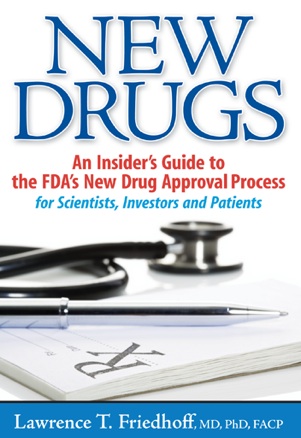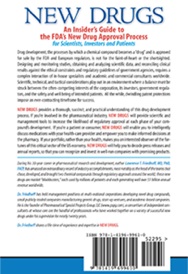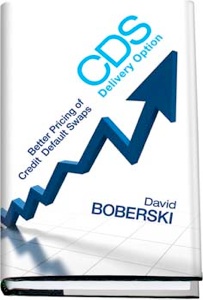NOW AVAILABLE ON AMAZON.COM
Format: softcover
ISBN: 9781419699610
Publisher: PSPG Press
Publication Date: June 2009
244 pages pages, 5.25" x 8"
The Reviews are In...
"Dr. Friedhoff has been a very effective consultant to our firm, and we have profited greatly from his insights. His book, New Drugs, is an eye-opening, inside look at an enormous and very complex sector of the economy, presented in a concise, well-written, and accessible manner. Highly recommended."
Oscar Schafer, Member of "Barron's Roundtable"
and Managing Partner of OSS Capital Management, NYC
"This is an excellent primer on the drug development process that importantly stresses the inter-relationship of studies in each part of the process. I will not only use this book in my course on drug discovery but will also recommend it to faculty interested in translational research."
Anthony Giordano, PhD
Assistant Dean of Research and Business Development, Office of Research
and Director, Experimental Therapeutics, Feist-Weiller Cancer Center
Louisiana State University, Shreveport, LA
"What an enjoyable read. I am a life science banker and I really enjoyed reading Dr. Friedhoff's book. Although I have been in the life science industry for over 17 years I was still able to learn a few things. Dr. Friedhoff's insights and clear outline of the drug development process really can benefit those who are new to drug development. I also liked the real-life examples which are pulled from the day's headlines. This should definitely be on the reading list for undergrads and business school students who are interested in drug development or life science banking."
D. Kolb, MBA
Pharma Banker
"As the author makes clear, he has learned from many years of drug development. NEW DRUGS really does reveal insider insights that cannot be found in other volumes. This book has been selected for The First Clinical Research Bookshelf."
Norman M. Goldfarb
Managing Director of First Clinical Research LLC
From the Back Cover:
Drug development, the processes by which a chemical compound becomes a “drug” and is approved for sale by the FDA, European and Asian regulators, is not for the faint-of-heart or the shortsighted. Designing and monitoring studies, obtaining and analyzing scientific data, and reconciling clinical results against the ethical constraints and regulatory guidelines of government agencies, requires a complex interaction of in-house specialists and academic and commercial consultants worldwide. Scientific, technical, and tactical considerations play out in an environment where a balance must be struck between the often-competing interests of the corporation, its investors, government regulators, and the safety and well being of intended patients. All the while, dwindling patent protections impose an ever contracting timeframe for success.
Written to be accessible to a wide audience, NEW DRUGS provides a thorough, succinct, and practical understanding of these drug development processes. If you’re involved in the pharmaceutical industry, NEW DRUGS will provide scientific and management tools to increase the likelihood of regulatory approval at each phase of your compound’s development. If you’re a patient or consumer, NEW DRUGS will enable you to intelligently discuss medications with your health-care provider and empower you to make informed decisions at the pharmacy. If your portfolio, rather than your health, makes you an interested observer of the fortunes of this critical sector of the US economy, NEW DRUGS will help you to decode press releases and annual reports, so that you can recognize and invest in well-run companies with promising products.

About the Author:
During his 30-year career in pharmaceutical research and development, author Lawrence T. Friedhoff, MD, PhD, FACP has amassed an extraordinary record of industry accomplishments, most notably as the head of the teams that chose, developed, and brought two chemical compounds through regulatory approvals around the world. These new drugs are market “blockbusters,” each used by millions of patients and each generating well over $1 billion annual revenue worldwide.
Dr. Friedhoff's first-hand knowledge of pharmaceutical R&D is extensive and comprehensive: he has held management positions at multi-national corporations developing novel drug compounds, small publicly-traded companies manufacturing generic rugs, start-up ventures, and academic-based research teams writing business plans to obtain venture capital. As an R&D head, he held primary responsibility for choosing drug candidates and preparing comprehensive plans for, as well as managing all phases of, their development, always with an eye towards fulfilling FDA (and often, European and Asian) drug requirements. He has also managed post-FDA-approval activities including collecting and analyzing adverse-event information from consumers, fielding inquiries from patients and healthcare providers, and marketing-related scientific studies.
Although the press contains numerous reports of disastrous failed clinical trials, during Dr. Friedhoff's career none of the completed pivotal clinical trials for which he was fully responsible ever failed and all of his new drug applications (NDA) submitted to the FDA were approved. Few industry professionals have been able match his achievements.
Dr. Friedhoff has obtained several patents and has been a frequent and off-cited contributor to the scientific literature. He is also the founder of Pharmaceutical Special Projects Group, LLC, a consortium of independent consultants at whose core are the handful of professionals who have worked together on a variety of successful new drugs under his supervision for nearly twenty years; the team provides various drug-development services to clients and is preparing to bring its own products to market. Visit http://www.pspg.com for further details.




Preface
Chapter 1 What is a Drug?
Chapter 2 Background
-
‣Economic Considerations
-
‣Risk Management
-
‣Key Personnel
Chapter 3 Finding Potential Drugs: The Initial Preclinical Evaluation
-
‣Practical Evaluation of New Product Candidates
-
‣General Considerations (Choosing the Indication; Mechanism of Action; Potency; Metabolites)
-
‣Initial Evaluations of Efficacy and Safety (Evaluations of Efficacy; Evaluation of Efficacy In Vitro; Evaluation of Safety In Vivo)
-
‣Evaluations of Safety (Toxicology: Mutagenicity, Effects on Cardiac Conduction, General Toxicology Evaluations; Safety Pharmacology)
-
‣Toxicokinetics
-
‣Metabolism
-
‣Evaluating the Risk/Benefit Ratio
Chapter 4 Ethical Concerns and Legal Considerations
-
‣General Ethical Considerations
-
‣Special Situations
-
‣The Forgotten Ethical Issue
-
‣Legal Considerations
Chapter 5 Initial Human Testing: The IND Application and Phase I Studies
-
‣The IND Application
-
‣Phase I Studies (The Single, Ascending-Dose Tolerance Study; The Multiple-Dose Tolerance Study; Special Evaluation of Cardiac Effects According to Worldwide Mandate)
-
‣Substance Testing During Manufacture
Chapter 6 Phase II Studies
-
‣Non-clinical Requirements for Initiation of Phase II
-
‣Design of Phase II Studies
-
‣Scientific Experts: Advisors and Investigators
-
‣Regulator Review of the Proposed Phase II Study
-
‣Implementation of Phase II
-
‣Political and Business Considerations
Chapter 7 Phase III Human Studies
-
‣Decision Point - Pressures and Considerations
-
‣Requirements for Initiation of Phase III
-
‣Implementation of Phase III Studies (Precautions for Implementation of Phase III Studies; Investigator Meeting; After the Meeting)
-
‣Phase III Extension Studies
Chapter 8 Late Stage Activities
-
‣Manufacturing
-
‣Non-clinical
-
‣Biopharmaceutics
-
‣Clinical Pharmacology
-
‣Integrating Late Stage Activities
-
‣Breaking the Blind and Final Steps
-
‣Political and Business Considerations
Chapter 9 A Word on Phase IV Studies
Chapter 10 NDA Submission and the NDA Submission Team
-
‣NDA Submission Team
-
‣Pre-NDA Meeting
-
‣General Considerations for Presenting NDA Data
-
‣NDA Documents
Chapter 11 The NDA Review Process
Chapter 12 The Challenge of Success
Chapter 13 Types of New Drug Applications: 505b1, 505b2 and 505j NDAs
Chapter 14 Inspections by Regulatory Agencies
Chapter 15 Rules of Thumb and Other “Tricks of the Trade”
-
‣ Evaluation of Personnel
-
‣ Evaluation of Companies
-
‣ Evaluation of Contract Research Organizations
-
‣ Regulatory Approval Documents
-
‣FDA Advisory Committee Meetings
-
‣Costs and Timelines
-
‣The Value of Being Second to Market
-
‣Development of Products Already Approved in Other Countries
-
‣Collaborations Between Companies
Chapter 16 Patents, Trademarks and Generic Names
-
‣Patents
-
‣Generic Names
-
‣Trademarks
-
‣National Drug Code
-
‣Product Appearance
Chapter 17 Special Considerations for Investors
-
‣Accounting Considerations
-
‣Emotional Considerations
-
‣Evaluating Companies - General Considerations
-
‣Specific Issues
-
‣Risks and Considerations (Pre-IND; Phase I; Phase II; Phase III)
Chapter 18 Case Studies and Personal Anecdotes
-
‣Tacrine
-
‣Gancyclovir
-
‣A Disgusting Adverse Event
-
‣CGIC
-
‣Arithmetic
-
‣The Projected Market for Alzheimer’s Disease Treatments
-
‣Proton Pump Inhibitors
-
‣Criminal Misbranding
-
‣Death Penalty
-
‣Heart Attack
Chapter 19 Safety Monitoring
Chapter 20 Who Gets Drugs Approved
Chapter 21 A Final Cautionary Note
Acknowledgements
Afterword
Glossary
Appendix 1 Types of New Drug Applications
Appendix 2 Inside Info: Open Secrets in the Pharmaceutical Industry
Appendix 3 FDA Non-Clinical Guidance Document
Appendix 4 Brief Discussion of Manufacturing Issues
Email: info@newdrugsbook.com
©2009 PSPG Press
All rights reserved






